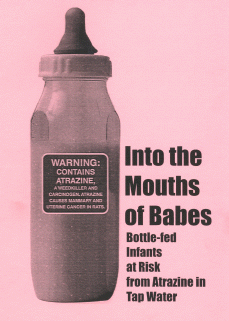Michael Fumento
Factual · Powerful · Original · Iconoclastic
A Killer of Babies Or Just Weeds? (extended version)
January 01, 1999 · Michael Fumento · Michael Fumento · EnvironmentHave you seen a live baby lately? From a slew of environmentalist "studies" pumped out recently, you’d think they’d be teetering on extinction. Fortunately, they’re doing just fine, thank you. Sadly, the same can’t be said for the mental health of the poor parents who may actually believe these groups.
The latest salvo was a report released last week at a press conference by the Environmental Working Group (EWG) claiming the popular herbicide atrazine is contaminating tap water, giving babies cancer.

"Ground zero" for the EWG’s Fear Bombs
"There’s no safe dose of atrazine for babies," says the EWG in demanding an immediate ban on the week killer.
Environmentalists usually attack chemicals not on the basis of actual or even perceived hazards, but on how useful they are. Atrazine fits the bill.
It’s been used for 40 years here, on about two-thirds of our corn, 60 percent of sorghum, and 90 percent of sugar cane. More than 80 other countries also use it.
Four years ago, the EPA began a still-ongoing special review of the triazine herbicide family, focusing on atrazine. Since it began, 100 new scientific studies and more than 80,000 public comments have been submitted to the agency. Faced with an overwhelming wall of scientific evidence, the EPA has (so far) refused to cave in to environmentalist demands for a ban.
All this new material the EWG ignores. Instead its latest "report" which like all EWG reports will never appear in a medical or science journal because it couldn’t possibly pass muster — focuses its cancer claims on studies done on a single species of rat.
The EWG’s report fails to note that last year the World Health Organization’s International Agency for Research on Cancer (IARC), completed its atrazine reassessment. It reversed its position that atrazine was a potential human carcinogen, concluding that the mammary tumor formation in the rats isn’t relevant to humans.

Even in Washington’s 95-degree heat, the EWG managed to produce a chilling cover for its report.
Atrazine, said IARC, is "not classifiable as to carcinogenicity to humans," placing it in the same cancer risk category as tea and talc.
A few very few of the reporters I attended the EWG press conference with were skeptical enough to ask about evidence in the most important animal, homo sapiens. They were given information that was false, grossly misleading, had absolutely nothing to do with atrazine, or combined all of the above.
Thus, EWG President Ken Cook claimed there’s evidence that childhood cancer was increasing. Were this true, it could be from a million factors other than atrazine exposure. But it’s not true.
According to the National Cancer Institute, adult cancer incidence is declining. Childhood cancer incidence increased for a few years due to earlier detection but the increase has stopped. A recent report from a country that uses atrazine, Canada, shows childhood cancer going down.
But "Studies have found increased cancer risks for farmers," claimed EWG Senior Analyst Jane Houlihan. Again it’s tough to see how atrazine could be presumed guilty when farmers are exposed to so many chemicals and other things at higher levels than non-farmers. But again, even the underlying claim is wrong.
Studies repeatedly show that overall farmers have less cancer, are healthier in general, and live longer than non-farmers. The largest and most recent to date, published last year in the Annals of Epidemiology, combined 37 studies and found yet again that farmers have lower overall rates of cancer. Only lip cancer was excessive, probably from sun exposure.
Bizarrely, Houlihan added that "Cancers that only occur in adults can be found in infants." Yikes, lady, if they’re in infants, then they’re not only found in adults. If she means "formerly only found in adults," how does that implicate a chemical used now for 40 years?
And so the press conference went. The written report hardly made more sense.
Naturally, the EWG says there are alternatives to atrazine. But Jere White, Executive Director of the Kansas Corn Growers Association, stated the obvious in telling me, "If there were other products that were safer and more cost-effective, we’d use them."
He also notes the irony of environmental groups crying crocodile tears over herbicide application when it was they who led to its greater use. That’s because herbicides can eliminate the need for tilling, a major contributor to soil erosion.
Another irony, White says, is that environmentalists also oppose biotech crops that reduce the need for herbicides and other types of pesticides, on the simple grounds that they’re biotech.
"We [farmers] have trouble figuring out what EWG supports other than the lack of a safe, abundant food supply," says White.
Giving the EWG an "A" for its slick packaging and ability to draw attention, but a failing grade for everything else is David Baker, director of the Water Quality Laboratory at Heidelberg College in Dublin, Ohio.
"The EWG selects only that information that supports their particular point of view," he told me. It "doesn’t involve objective scientific assessment, nor does it lead to good public policy."
On the other hand, it is an excellent policy to foment false fear if you’re an environmentalist group that can only keep its coffers filled by churning out scary reports every few months. At the press conference, Cook declared, "New moms should not have to worry." How ironic, when making them worry needlessly is his group’s raison d’etre?
